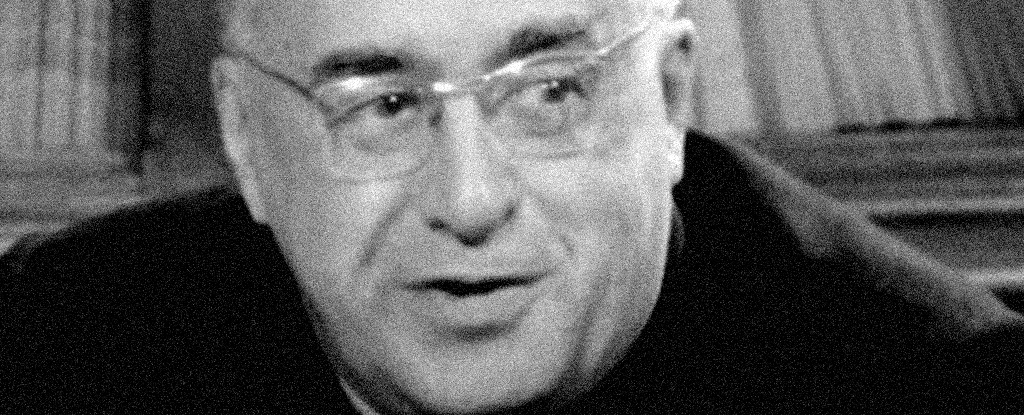It’s not every day that you rediscover the words of a world-renowned thinker who influenced Albert Einstein himself.
A nearly 20-minute video interview with the ‘Father of the Big Bang‘ was found in the archives of a public broadcaster called Vlaamse Radio- en Televisieomroeporganisatie (VRT) in the Flemish region of Belgium.
Scientists looking at the lost footage to sayIt feels like “looking through time”.
The intellectual interview, conducted in French, was originally broadcast in 1964 and the footage was believed to be lost. Now it has finally been recovered and is available online for everyone, albeit with Flemish subtitles. An English translation has also been provided in a preprint paper for those who do not speak Flemish or French arXiv.
Georges Lemaitre was a Belgian cosmologist and Catholic priest who first discovered that the universe is expanding, even before Edwin Hubble demonstrated the effect with the largest telescope in the world.
Ultimately Lemaître’s logic convinced Einstein in the early 1930s to accept that he was wrong and that the universe could not be static in light of this general theory of relativity.
According to Lemaître, the universe was hatched from a primeval ‘cosmic egg’an atom that had exploded into one constantly growing fireworks of cosmic rays that continues to this day.
frameborder=”0″ allow=”accelerometer; autoplay; write clipboard; encrypted media; gyroscope; picture in picture; web-share” allowfullscreen>
Not everyone was convinced of Lemaître’s theory, however, and much of his interview in 1964 was devoted to refuting his challengers.
“A very long time ago”, Lemaître explained in footage: “Before the theory of the expansion of the universe (about 40 years ago) we expected the universe to be static. We expected that nothing would change.”
This is known as the steady-state hypothesisan idea championed by the English astronomer Fred Hoyle to oppose Lemaître’s ideas.
According to Hoylethe universe constantly created new matter in an unchanging yet dynamic way, like a “calmly flowing river”.
If this is true, if matter is continuously being created and sent downstream, then there should be a mix of young and old galaxies scattered throughout the universe.
On the other hand, the Big Bang (a term coined by Hoyle) would mean that older galaxies are farther from the epicenter of the explosion.
These two scenarios were hotly debated for many years, and it was not until the 1950s that astronomical observations confirmed the latter situation.
“What will be the first result of this decay, as far as we can follow the theory, is actually a universe, an expanding space filled with a plasma, of very energetic jets going in all directions,” Lemaître said explained in the recently rediscovered interview.
“Something that doesn’t look like a homogeneous gas at all. Then, through a process that we can vaguely imagine, we unfortunately cannot understand that gases had to form locally in very many details; Gas clouds moving at great speed…”
Both Hoyle and Lemaître agreed that these gas clouds consist almost entirely of hydrogen. But the two scientists disagreed on how these hydrogen gases formed.
Hoyle thought they were made naturally by “a reasonable physical process”, explained Lemaître in an interview. Lemaître viewed the beginning as “a sort of phantom hydrogen appearing with just the right amount of hydrogen to confirm an a priori law”.
The cosmic rays that shoot through the universe are essentially fossils of that primordial spooky atom.
“Of all the people who developed the framework of cosmology that we are working with now, there is very little record of them speaking about their work.” says US Department of Energy physicist Satya Gontcho A Gontcho, co-author of the preprint paper.
One of the most compelling parts of the lost interview is when Lemaître is asked how he reconciles his scientific theory with his religion.
“I’m not defending the primordial atom out of any religious ulterior motives,” he says says in the interview.
“It’s a point that’s obviously a bit delicate,” he adds. “I’m a bit scared to explain it in a few words now.”
The astronomer and priest neither found that the Big Bang contradicted his religion nor did he believe that science required a religious explanation. The subject was clearly not one he was interested in openly discussing.
“Lemaître and others have given us the mathematical framework that forms the basis of our current efforts to understand our universe,” says goncho.
“Cosmology tries to understand what happened in the past of the universe – and for most of us who make observations that means measuring very precisely the rate of acceleration of the universe at different points in time. And if you understand how the universe is expanding at different points in time, then you can narrow down what dark energy could be.”
The translated interview is available as a preprint at arXiv.





